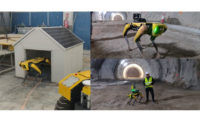Construction engineering and management is different from other scientific and management disciplines. We take advantage of proven technologies and try to turn them into cost-effective solutions in the construction field. We must devise ways of solving problems with clarity and ease, while always thinking of the practical reality of how things should be done.
I’m now on the edge of proving out such a product that stands as an example of what we can expect to see in the industry in coming years. It is an automated surveying robot that provides the position of a tunnel boring machine in real time. It’s being field tested on a nearly complete 1000m sewage tunneling job in the city of Edmonton, Alberta. The tunnel test bed showcases th future of technology integration and automation in construction in the coming 10 years.
It’s unlikely that we will see a revolution of means and methods as we are employing today. For example, TBM plus precast sections to build tunnels, crane plus prefabricated modules to install buildings or plants.
We are not likely going to see robots replace humans in the field. Instead, we will see equipment operators, like the ones on our project, making decisions on the fly, assisted by “add-on” robotic instruments and sensors, which will lead to significant improvement in precision, efficiency and safety in field operations.
As field activities unfold, construction managers will have access to 3D platforms refreshed on a near real-time basis, consisting of as-built models alongside as-designed models, empowered by simulation and optimization analyses. This not only facilitates project control in terms of time, cost and quality, but turns the management of deviation corrections, design changes and schedule updates into a straightforward, transparent decision process for all the stakeholders involved.
The development of “add-on” technologies will enable people, but not replace people. In addition to providing opportunities to train post doctoral and postgraduate students at the university, the “add-on” technologies will also be instrumental in training equipment operators and field engineers and surveyors by readily capturing the technical knowhow and implicit knowledge of experienced field personnel. This potentially lays a fast-track solution to addressing the current and worsening “skills crunch” and “manpower shortage” issues that present a bottleneck to the growth of construction industry in both developed and developing countries.
At the University of Alberta, academics are teaming with industry partners and intend to propagate our success achieved in tunnel construction into other construction domains critical to social and economical development of Alberta, including oil sands mine development, industrial plant construction, and building construction.
Ming Lu is an Associate Professor of construction engineering and management, at the University of Alberta. He will be presenting some of his ideas at the upcoming San Antonia Fiatech conference.




Post a comment to this article
Report Abusive Comment